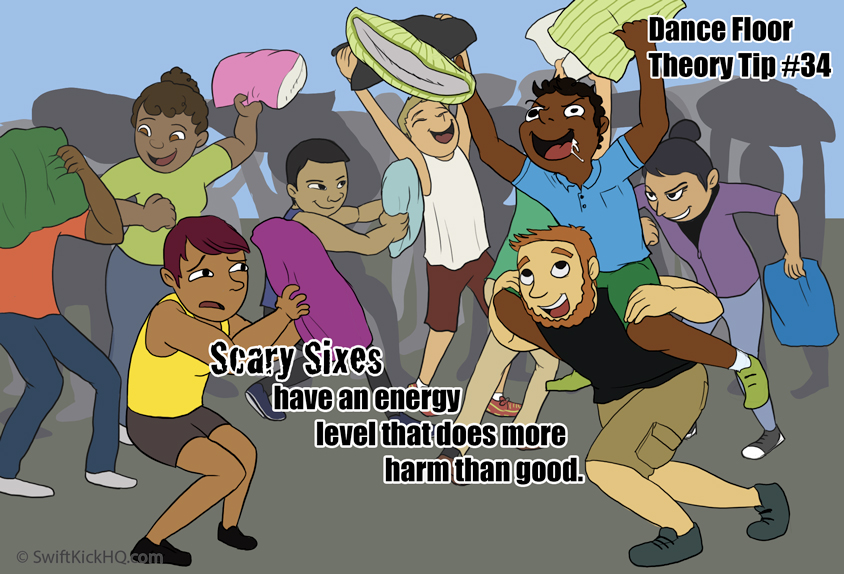Robyn works at a large cosmetics company where meetings happen every day, all day. Others on the team describe her as loud, excited, and never-ending. In meetings, there is often no reason for Robyn to answer questions, but she does anyway. Many times, the questions aren’t related to her job, and she doesn’t even have experience in that area. The challenge is that sometimes Robyn does have good ideas. But when she insists on speaking first, loudest, and longest during every section of the meeting, it’s hard to parse through what’s valuable and what’s not. Many on the team wish she would stay quiet and listen while others speak. The more she talks, the quieter everyone else becomes, which is a bad sign for team engagement.
Untrained motivation and excitement is like having five shots of espresso. The intended result of increased energy might actually do more harm than good. In our Dance Floor Theory training, we call these people Scary Sixes.
Scary Sixes have an energy level that does more harm than good
Here are three prime examples of Scary Sixes:
Overly Extroverted – Someone who tests high on the extrovert scale and is filled with in-your-face energy. Up to 1/2 of the population are considered introverts, according to Quiet:The Power of Introverts in a World That Can’t Stop Talking author Susan Cain. So the danger of an overly extroverted person is that their energy can be off-putting to introverts and ambiverts. The result will be a decrease in connection and team engagement.
Blindly Optimistic – This is someone who continuously ignores the reality of negative facts when speaking or making decisions. While optimism can be a good thing, danger arises when the negatives aren’t taken into account. This can be detrimental to success. In Jim Collins book, “Good To Great,” he calls this The Stockdale Paradox.
“Productive change begins when you confront the brutal facts. You must maintain unwavering faith that you can and will prevail in the end, regardless of the difficulties, and at the same time, have the discipline to confront the most brutal facts of your current reality, whatever they might be.”
Jim Collins ” Good To Great”
Loud Mouths – This is someone who regularly talks first, loudest, and often during conversations and meetings. Robyn from above fits this profile. The danger of loud mouths is that they don’t often think through what they want to say, so they waste everyone’s time. They also dominate conversation and block other voices from being heard. This is dangerous, especially when you take into account a survey published in the Harvard Business Review that said that only 35% of employees feel able to make a contribution in a meeting when they have something to say.
“If we assume that quiet and loud people have roughly the same number of good (and bad) ideas, then we should worry if the louder and more forceful people always carry the day.”
Susan Cain “Quiet”
In reading through the three examples above, you might recognize someone on your team as a Scary Six, or maybe even yourself. The good news is that not all hope is lost and you can mitigate the negative effects of Scary Sixes with these three steps:
- Acknowledge the issue Either for yourself or by confronting someone else, the first step is to simply acknowledge the issue exists, as many people are ignorant to the issue and the negative side effects. Maybe you need to set up a one-on-one conversation with the Scary Six. Make sure you have specific examples of the person being a Scary Six so the conversation is more objective than subjective. There are actually apps that allow you to track who talks the most during conversations.
- Define action steps If you want to allow other voices in meetings to be heard instead of Scary Sixes, then create an action plan that challenges the Scary Six to talk less, while also encouraging others to speak up. For example, in parts of our team meetings, the meeting organizer will call out each person, one at a time, to have them answer. You could also challenge the Scary Six to write down what they want to say before they say it, as a way for them to really determine if it’s valuable enough for everyone to hear.
- Create the Urgency Habits rarely change overnight without enough pain, or pleasure, to do so. Knowing that their job, or a future promotion, is on the line, a Scary Six should be motivated enough to want to change quickly. Make sure you make this known so the person is motivated to change.
- Test and Assess Create a series of check-ins with the Scary Six to see if they are improving. If they are, celebrate their growth. If they aren’t, be ready and willing to let them go so you can have strong team unity. Keeping them on the team will only do more damage than good, because as Facebook’s COO, Sheryl Sandberg, says, “Teams that work together well outperform those that don’t.”
Robyn, our Scary Six from the cosmetics company, was spoken to about her behavior and how it was negatively impacting the group. But she didn’t do the work needed to change her behavior during team meetings. The net result was that the rest of the team continued to resent her contributions and her being a part of the team. Ultimately, Robyn left the company.
Robyn is a case study in what happens when Scary Sixes aren’t confronted and don’t change. If you have a Scary Six on your team, or you recognize yourself as being one, use the steps above to change now, because the alternative isn’t good.




